NURS6900: Critical Analysis of Sleep Intervention Meta-Analysis
VerifiedAdded on 2022/08/08
|9
|1987
|25
Report
AI Summary
This report offers a critical analysis of a meta-analysis examining the effects of non-pharmacological sleep interventions on depression symptoms. The analysis focuses on a specific article that reviewed randomized controlled trials to determine whether improving sleep quality through non-drug interventions could reduce depression. The report delves into the review's objectives, methodology, including inclusion/exclusion criteria, databases used, and search terms. It assesses the quality of the included studies, data abstraction, and synthesis processes. Limitations of the study are also discussed. The report highlights the evidence levels, knowledge gained, and the review's implications for health practices, ultimately concluding that non-pharmacological sleep therapy is a cost-effective treatment option for patients experiencing both depression and sleep disturbances. The analysis also notes the strengths and weaknesses of the meta-analysis, providing a comprehensive understanding of the research findings and their practical application.
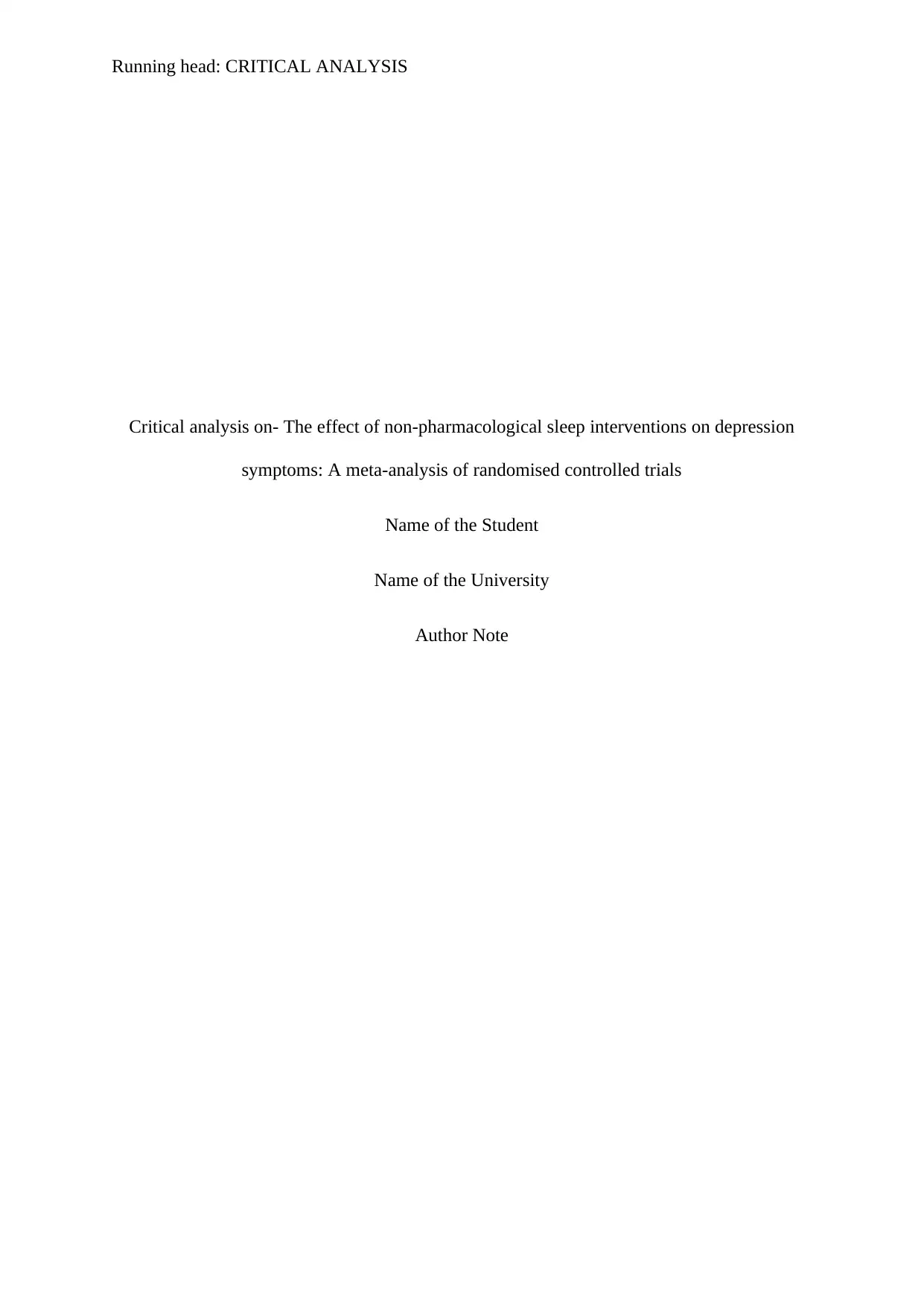
Running head: CRITICAL ANALYSIS
Critical analysis on- The effect of non-pharmacological sleep interventions on depression
symptoms: A meta-analysis of randomised controlled trials
Name of the Student
Name of the University
Author Note
Critical analysis on- The effect of non-pharmacological sleep interventions on depression
symptoms: A meta-analysis of randomised controlled trials
Name of the Student
Name of the University
Author Note
Paraphrase This Document
Need a fresh take? Get an instant paraphrase of this document with our AI Paraphraser
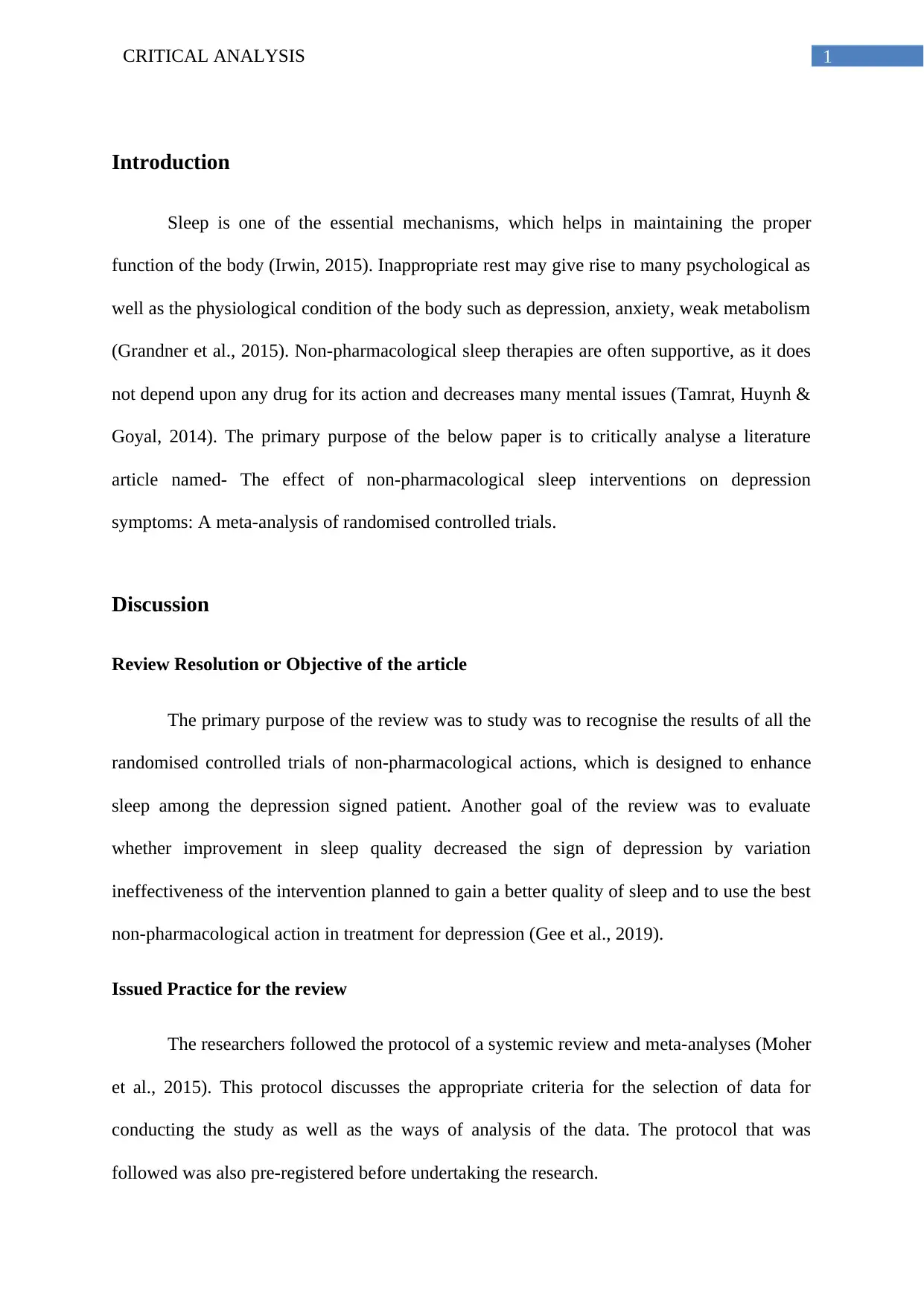
1CRITICAL ANALYSIS
Introduction
Sleep is one of the essential mechanisms, which helps in maintaining the proper
function of the body (Irwin, 2015). Inappropriate rest may give rise to many psychological as
well as the physiological condition of the body such as depression, anxiety, weak metabolism
(Grandner et al., 2015). Non-pharmacological sleep therapies are often supportive, as it does
not depend upon any drug for its action and decreases many mental issues (Tamrat, Huynh &
Goyal, 2014). The primary purpose of the below paper is to critically analyse a literature
article named- The effect of non-pharmacological sleep interventions on depression
symptoms: A meta-analysis of randomised controlled trials.
Discussion
Review Resolution or Objective of the article
The primary purpose of the review was to study was to recognise the results of all the
randomised controlled trials of non-pharmacological actions, which is designed to enhance
sleep among the depression signed patient. Another goal of the review was to evaluate
whether improvement in sleep quality decreased the sign of depression by variation
ineffectiveness of the intervention planned to gain a better quality of sleep and to use the best
non-pharmacological action in treatment for depression (Gee et al., 2019).
Issued Practice for the review
The researchers followed the protocol of a systemic review and meta-analyses (Moher
et al., 2015). This protocol discusses the appropriate criteria for the selection of data for
conducting the study as well as the ways of analysis of the data. The protocol that was
followed was also pre-registered before undertaking the research.
Introduction
Sleep is one of the essential mechanisms, which helps in maintaining the proper
function of the body (Irwin, 2015). Inappropriate rest may give rise to many psychological as
well as the physiological condition of the body such as depression, anxiety, weak metabolism
(Grandner et al., 2015). Non-pharmacological sleep therapies are often supportive, as it does
not depend upon any drug for its action and decreases many mental issues (Tamrat, Huynh &
Goyal, 2014). The primary purpose of the below paper is to critically analyse a literature
article named- The effect of non-pharmacological sleep interventions on depression
symptoms: A meta-analysis of randomised controlled trials.
Discussion
Review Resolution or Objective of the article
The primary purpose of the review was to study was to recognise the results of all the
randomised controlled trials of non-pharmacological actions, which is designed to enhance
sleep among the depression signed patient. Another goal of the review was to evaluate
whether improvement in sleep quality decreased the sign of depression by variation
ineffectiveness of the intervention planned to gain a better quality of sleep and to use the best
non-pharmacological action in treatment for depression (Gee et al., 2019).
Issued Practice for the review
The researchers followed the protocol of a systemic review and meta-analyses (Moher
et al., 2015). This protocol discusses the appropriate criteria for the selection of data for
conducting the study as well as the ways of analysis of the data. The protocol that was
followed was also pre-registered before undertaking the research.
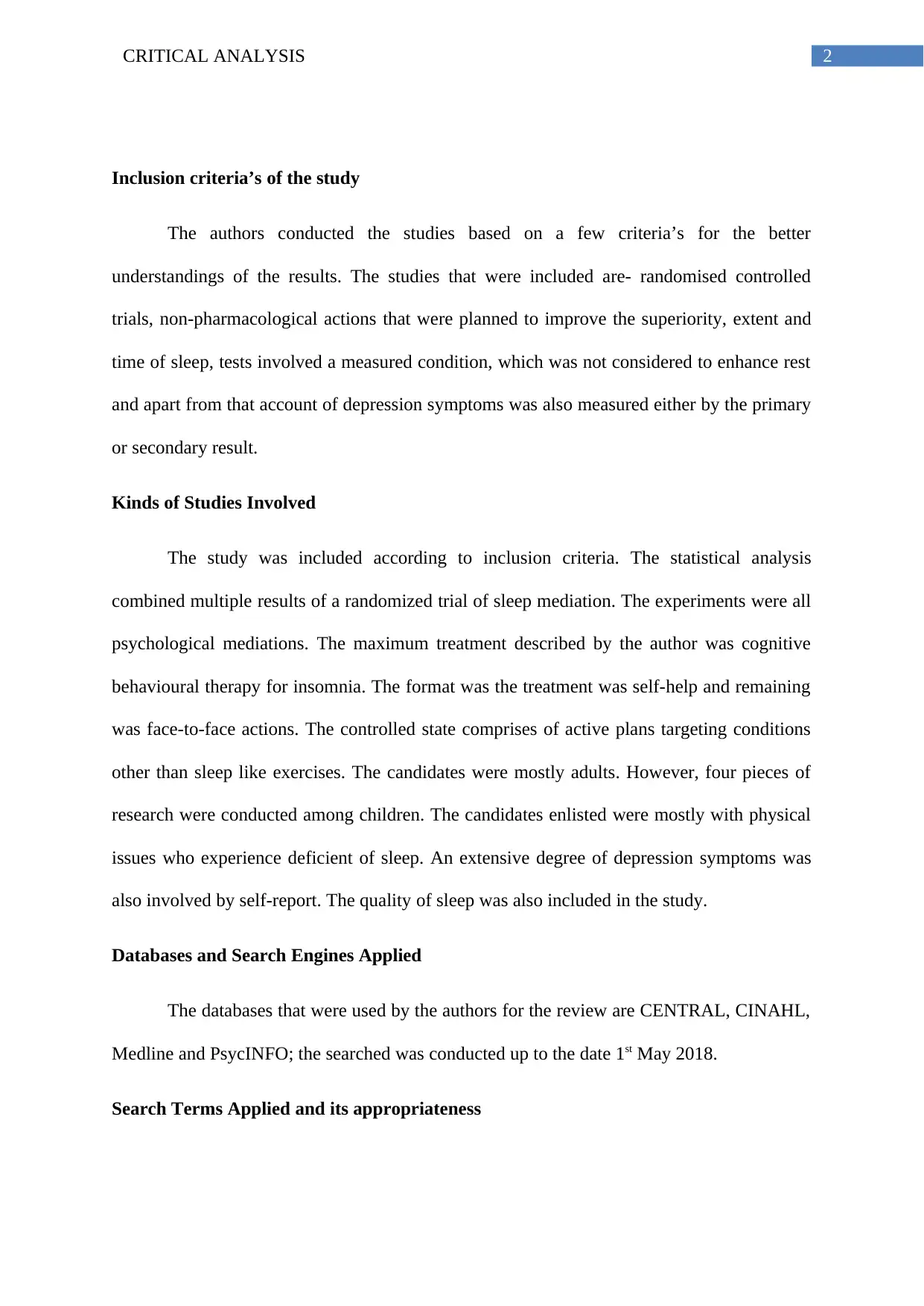
2CRITICAL ANALYSIS
Inclusion criteria’s of the study
The authors conducted the studies based on a few criteria’s for the better
understandings of the results. The studies that were included are- randomised controlled
trials, non-pharmacological actions that were planned to improve the superiority, extent and
time of sleep, tests involved a measured condition, which was not considered to enhance rest
and apart from that account of depression symptoms was also measured either by the primary
or secondary result.
Kinds of Studies Involved
The study was included according to inclusion criteria. The statistical analysis
combined multiple results of a randomized trial of sleep mediation. The experiments were all
psychological mediations. The maximum treatment described by the author was cognitive
behavioural therapy for insomnia. The format was the treatment was self-help and remaining
was face-to-face actions. The controlled state comprises of active plans targeting conditions
other than sleep like exercises. The candidates were mostly adults. However, four pieces of
research were conducted among children. The candidates enlisted were mostly with physical
issues who experience deficient of sleep. An extensive degree of depression symptoms was
also involved by self-report. The quality of sleep was also included in the study.
Databases and Search Engines Applied
The databases that were used by the authors for the review are CENTRAL, CINAHL,
Medline and PsycINFO; the searched was conducted up to the date 1st May 2018.
Search Terms Applied and its appropriateness
Inclusion criteria’s of the study
The authors conducted the studies based on a few criteria’s for the better
understandings of the results. The studies that were included are- randomised controlled
trials, non-pharmacological actions that were planned to improve the superiority, extent and
time of sleep, tests involved a measured condition, which was not considered to enhance rest
and apart from that account of depression symptoms was also measured either by the primary
or secondary result.
Kinds of Studies Involved
The study was included according to inclusion criteria. The statistical analysis
combined multiple results of a randomized trial of sleep mediation. The experiments were all
psychological mediations. The maximum treatment described by the author was cognitive
behavioural therapy for insomnia. The format was the treatment was self-help and remaining
was face-to-face actions. The controlled state comprises of active plans targeting conditions
other than sleep like exercises. The candidates were mostly adults. However, four pieces of
research were conducted among children. The candidates enlisted were mostly with physical
issues who experience deficient of sleep. An extensive degree of depression symptoms was
also involved by self-report. The quality of sleep was also included in the study.
Databases and Search Engines Applied
The databases that were used by the authors for the review are CENTRAL, CINAHL,
Medline and PsycINFO; the searched was conducted up to the date 1st May 2018.
Search Terms Applied and its appropriateness
⊘ This is a preview!⊘
Do you want full access?
Subscribe today to unlock all pages.

Trusted by 1+ million students worldwide
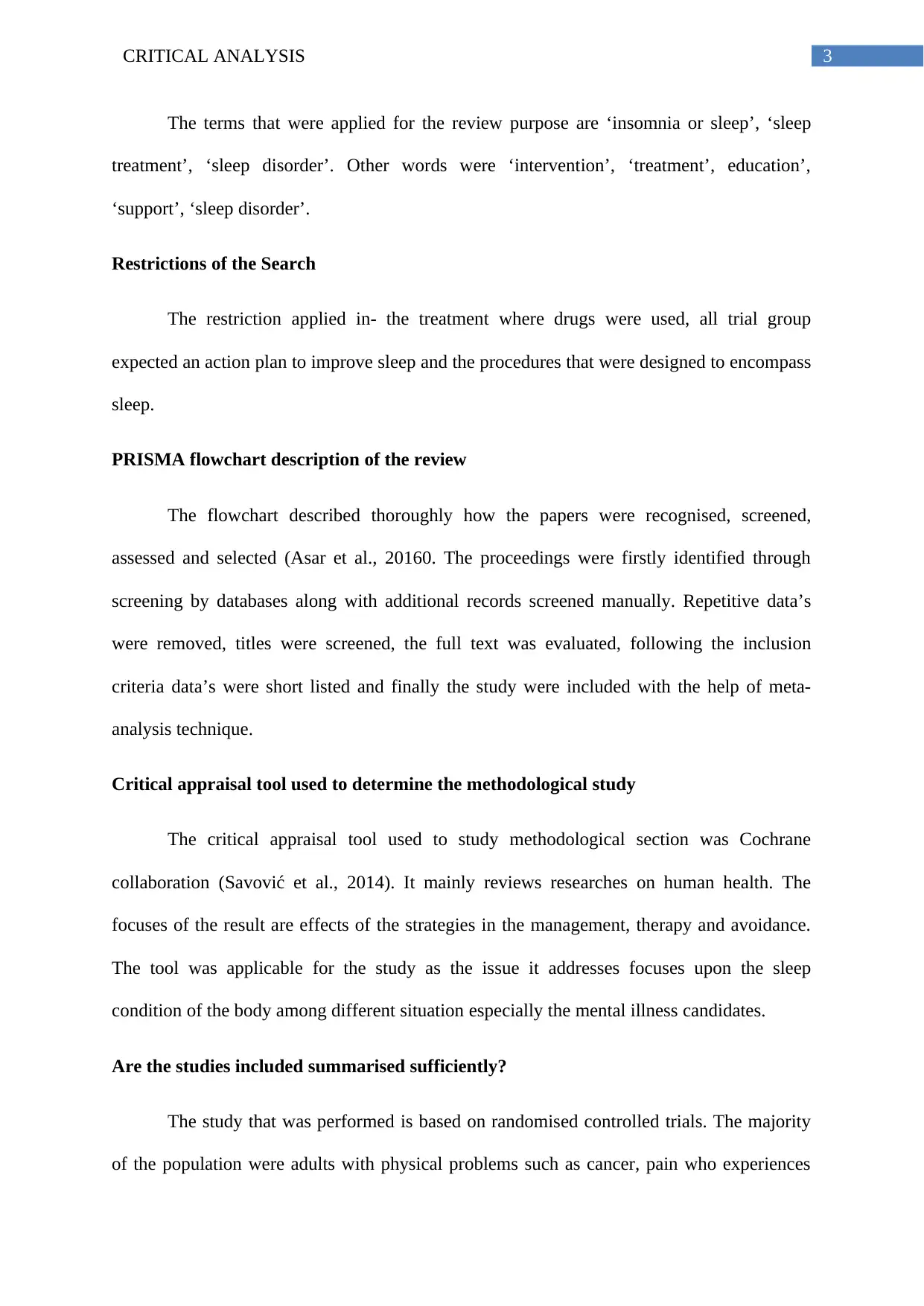
3CRITICAL ANALYSIS
The terms that were applied for the review purpose are ‘insomnia or sleep’, ‘sleep
treatment’, ‘sleep disorder’. Other words were ‘intervention’, ‘treatment’, education’,
‘support’, ‘sleep disorder’.
Restrictions of the Search
The restriction applied in- the treatment where drugs were used, all trial group
expected an action plan to improve sleep and the procedures that were designed to encompass
sleep.
PRISMA flowchart description of the review
The flowchart described thoroughly how the papers were recognised, screened,
assessed and selected (Asar et al., 20160. The proceedings were firstly identified through
screening by databases along with additional records screened manually. Repetitive data’s
were removed, titles were screened, the full text was evaluated, following the inclusion
criteria data’s were short listed and finally the study were included with the help of meta-
analysis technique.
Critical appraisal tool used to determine the methodological study
The critical appraisal tool used to study methodological section was Cochrane
collaboration (Savović et al., 2014). It mainly reviews researches on human health. The
focuses of the result are effects of the strategies in the management, therapy and avoidance.
The tool was applicable for the study as the issue it addresses focuses upon the sleep
condition of the body among different situation especially the mental illness candidates.
Are the studies included summarised sufficiently?
The study that was performed is based on randomised controlled trials. The majority
of the population were adults with physical problems such as cancer, pain who experiences
The terms that were applied for the review purpose are ‘insomnia or sleep’, ‘sleep
treatment’, ‘sleep disorder’. Other words were ‘intervention’, ‘treatment’, education’,
‘support’, ‘sleep disorder’.
Restrictions of the Search
The restriction applied in- the treatment where drugs were used, all trial group
expected an action plan to improve sleep and the procedures that were designed to encompass
sleep.
PRISMA flowchart description of the review
The flowchart described thoroughly how the papers were recognised, screened,
assessed and selected (Asar et al., 20160. The proceedings were firstly identified through
screening by databases along with additional records screened manually. Repetitive data’s
were removed, titles were screened, the full text was evaluated, following the inclusion
criteria data’s were short listed and finally the study were included with the help of meta-
analysis technique.
Critical appraisal tool used to determine the methodological study
The critical appraisal tool used to study methodological section was Cochrane
collaboration (Savović et al., 2014). It mainly reviews researches on human health. The
focuses of the result are effects of the strategies in the management, therapy and avoidance.
The tool was applicable for the study as the issue it addresses focuses upon the sleep
condition of the body among different situation especially the mental illness candidates.
Are the studies included summarised sufficiently?
The study that was performed is based on randomised controlled trials. The majority
of the population were adults with physical problems such as cancer, pain who experiences
Paraphrase This Document
Need a fresh take? Get an instant paraphrase of this document with our AI Paraphraser

4CRITICAL ANALYSIS
sleep problems. Another study was conducted depending upon only sleep issue rejecting any
other additional condition. The treatments were adequately summarised like self-help
cognitive behavioural therapy, educational support, online programmes, sleep hygiene and
relaxation. The tests were conducted in Europe, North America, Asia and Australia. The
results and outcomes of the studies summarises the fact that use of non-pharmacological
sleep treatments is useful in dropping depression mainly clinical patients.
Are excluded studies justified with reason?
The authors excluded a few of the studies from the review depending upon a few
conditions. The reason for the elimination was also explained by the author in the paper.
Some of the intentions are control group that is planned to enhance sleep, depression not
measured as an outcome, the study that was not based upon randomised controlled trials and
the papers where the plans are not designed to enhance the sleep. Other reasons were
overlapping of data’s and incomplete information.
Data Abstracted and Synthesised
The data was extracted by the help of extraction spreadsheet. The information about
the data that were included are- treatment type, age of the group, condition of the condition,
depression level, quality of sleep, and the control groups. The depression level was measured
twice before the treatment and once after the application of the procedure.
The studies with full information based upon the depression effect were included in
the meta-analysis. Standardised level of difference was applied in the depression values after
the treatment and their level of response was calculated among the participated group and
weighed as well. The mean difference greater than 0.8 is regarded as enormous, 0.5 was
adequate and 0.2 was considered as small. The plans where more treatments were included in
the data with most intensive care was taken in the meta-analysis. The exhaustive data was
sleep problems. Another study was conducted depending upon only sleep issue rejecting any
other additional condition. The treatments were adequately summarised like self-help
cognitive behavioural therapy, educational support, online programmes, sleep hygiene and
relaxation. The tests were conducted in Europe, North America, Asia and Australia. The
results and outcomes of the studies summarises the fact that use of non-pharmacological
sleep treatments is useful in dropping depression mainly clinical patients.
Are excluded studies justified with reason?
The authors excluded a few of the studies from the review depending upon a few
conditions. The reason for the elimination was also explained by the author in the paper.
Some of the intentions are control group that is planned to enhance sleep, depression not
measured as an outcome, the study that was not based upon randomised controlled trials and
the papers where the plans are not designed to enhance the sleep. Other reasons were
overlapping of data’s and incomplete information.
Data Abstracted and Synthesised
The data was extracted by the help of extraction spreadsheet. The information about
the data that were included are- treatment type, age of the group, condition of the condition,
depression level, quality of sleep, and the control groups. The depression level was measured
twice before the treatment and once after the application of the procedure.
The studies with full information based upon the depression effect were included in
the meta-analysis. Standardised level of difference was applied in the depression values after
the treatment and their level of response was calculated among the participated group and
weighed as well. The mean difference greater than 0.8 is regarded as enormous, 0.5 was
adequate and 0.2 was considered as small. The plans where more treatments were included in
the data with most intensive care was taken in the meta-analysis. The exhaustive data was
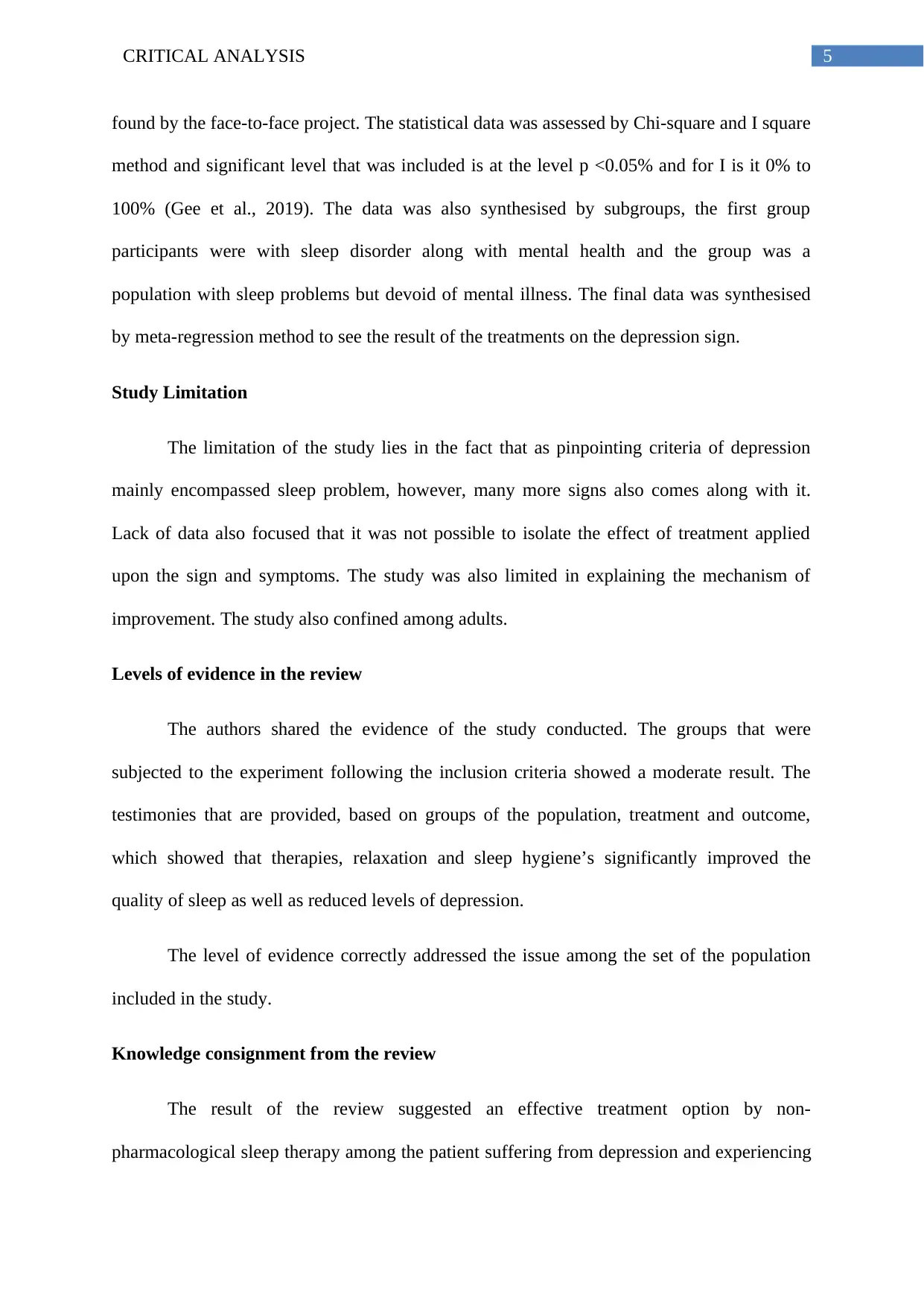
5CRITICAL ANALYSIS
found by the face-to-face project. The statistical data was assessed by Chi-square and I square
method and significant level that was included is at the level p <0.05% and for I is it 0% to
100% (Gee et al., 2019). The data was also synthesised by subgroups, the first group
participants were with sleep disorder along with mental health and the group was a
population with sleep problems but devoid of mental illness. The final data was synthesised
by meta-regression method to see the result of the treatments on the depression sign.
Study Limitation
The limitation of the study lies in the fact that as pinpointing criteria of depression
mainly encompassed sleep problem, however, many more signs also comes along with it.
Lack of data also focused that it was not possible to isolate the effect of treatment applied
upon the sign and symptoms. The study was also limited in explaining the mechanism of
improvement. The study also confined among adults.
Levels of evidence in the review
The authors shared the evidence of the study conducted. The groups that were
subjected to the experiment following the inclusion criteria showed a moderate result. The
testimonies that are provided, based on groups of the population, treatment and outcome,
which showed that therapies, relaxation and sleep hygiene’s significantly improved the
quality of sleep as well as reduced levels of depression.
The level of evidence correctly addressed the issue among the set of the population
included in the study.
Knowledge consignment from the review
The result of the review suggested an effective treatment option by non-
pharmacological sleep therapy among the patient suffering from depression and experiencing
found by the face-to-face project. The statistical data was assessed by Chi-square and I square
method and significant level that was included is at the level p <0.05% and for I is it 0% to
100% (Gee et al., 2019). The data was also synthesised by subgroups, the first group
participants were with sleep disorder along with mental health and the group was a
population with sleep problems but devoid of mental illness. The final data was synthesised
by meta-regression method to see the result of the treatments on the depression sign.
Study Limitation
The limitation of the study lies in the fact that as pinpointing criteria of depression
mainly encompassed sleep problem, however, many more signs also comes along with it.
Lack of data also focused that it was not possible to isolate the effect of treatment applied
upon the sign and symptoms. The study was also limited in explaining the mechanism of
improvement. The study also confined among adults.
Levels of evidence in the review
The authors shared the evidence of the study conducted. The groups that were
subjected to the experiment following the inclusion criteria showed a moderate result. The
testimonies that are provided, based on groups of the population, treatment and outcome,
which showed that therapies, relaxation and sleep hygiene’s significantly improved the
quality of sleep as well as reduced levels of depression.
The level of evidence correctly addressed the issue among the set of the population
included in the study.
Knowledge consignment from the review
The result of the review suggested an effective treatment option by non-
pharmacological sleep therapy among the patient suffering from depression and experiencing
⊘ This is a preview!⊘
Do you want full access?
Subscribe today to unlock all pages.

Trusted by 1+ million students worldwide
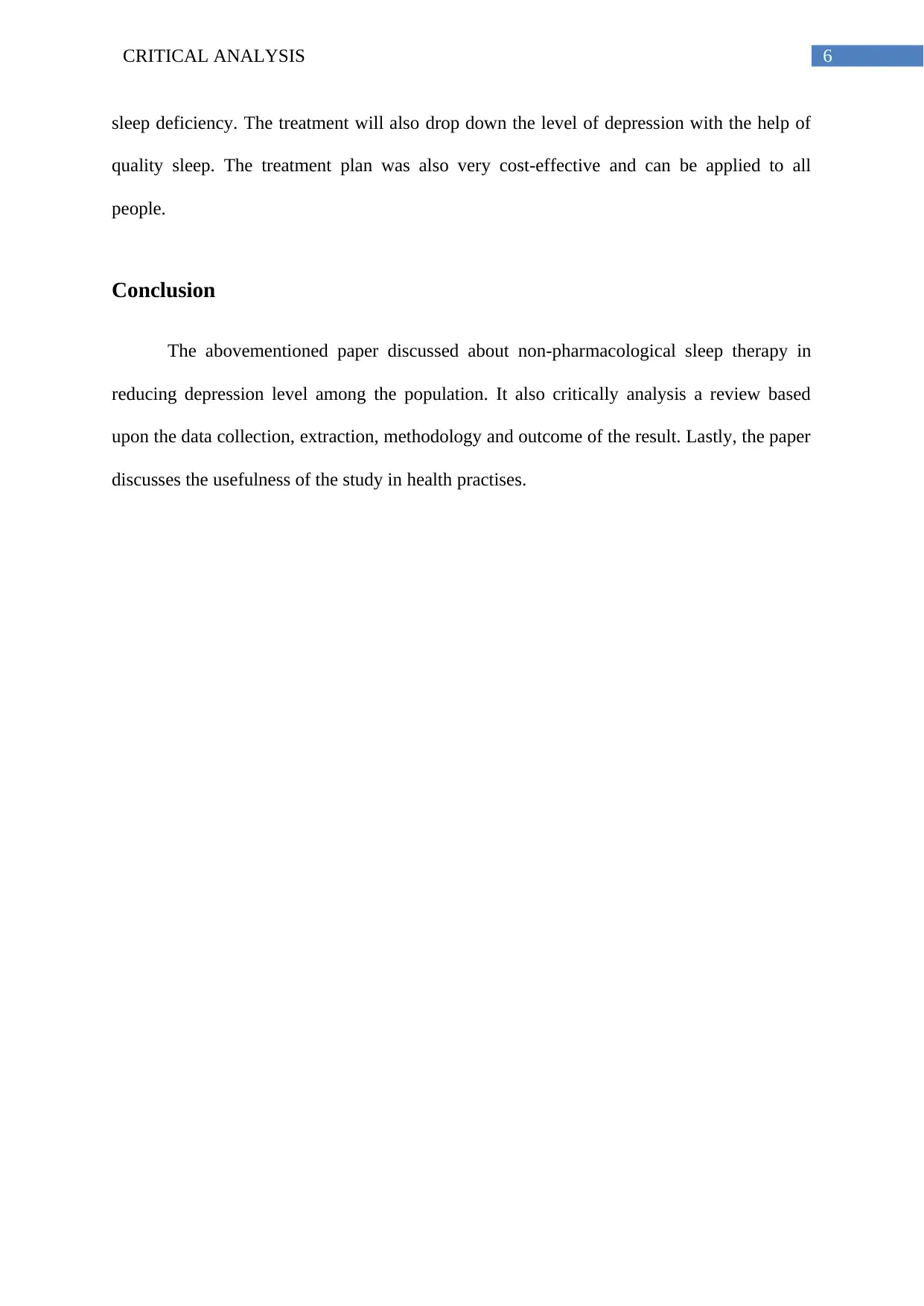
6CRITICAL ANALYSIS
sleep deficiency. The treatment will also drop down the level of depression with the help of
quality sleep. The treatment plan was also very cost-effective and can be applied to all
people.
Conclusion
The abovementioned paper discussed about non-pharmacological sleep therapy in
reducing depression level among the population. It also critically analysis a review based
upon the data collection, extraction, methodology and outcome of the result. Lastly, the paper
discusses the usefulness of the study in health practises.
sleep deficiency. The treatment will also drop down the level of depression with the help of
quality sleep. The treatment plan was also very cost-effective and can be applied to all
people.
Conclusion
The abovementioned paper discussed about non-pharmacological sleep therapy in
reducing depression level among the population. It also critically analysis a review based
upon the data collection, extraction, methodology and outcome of the result. Lastly, the paper
discusses the usefulness of the study in health practises.
Paraphrase This Document
Need a fresh take? Get an instant paraphrase of this document with our AI Paraphraser
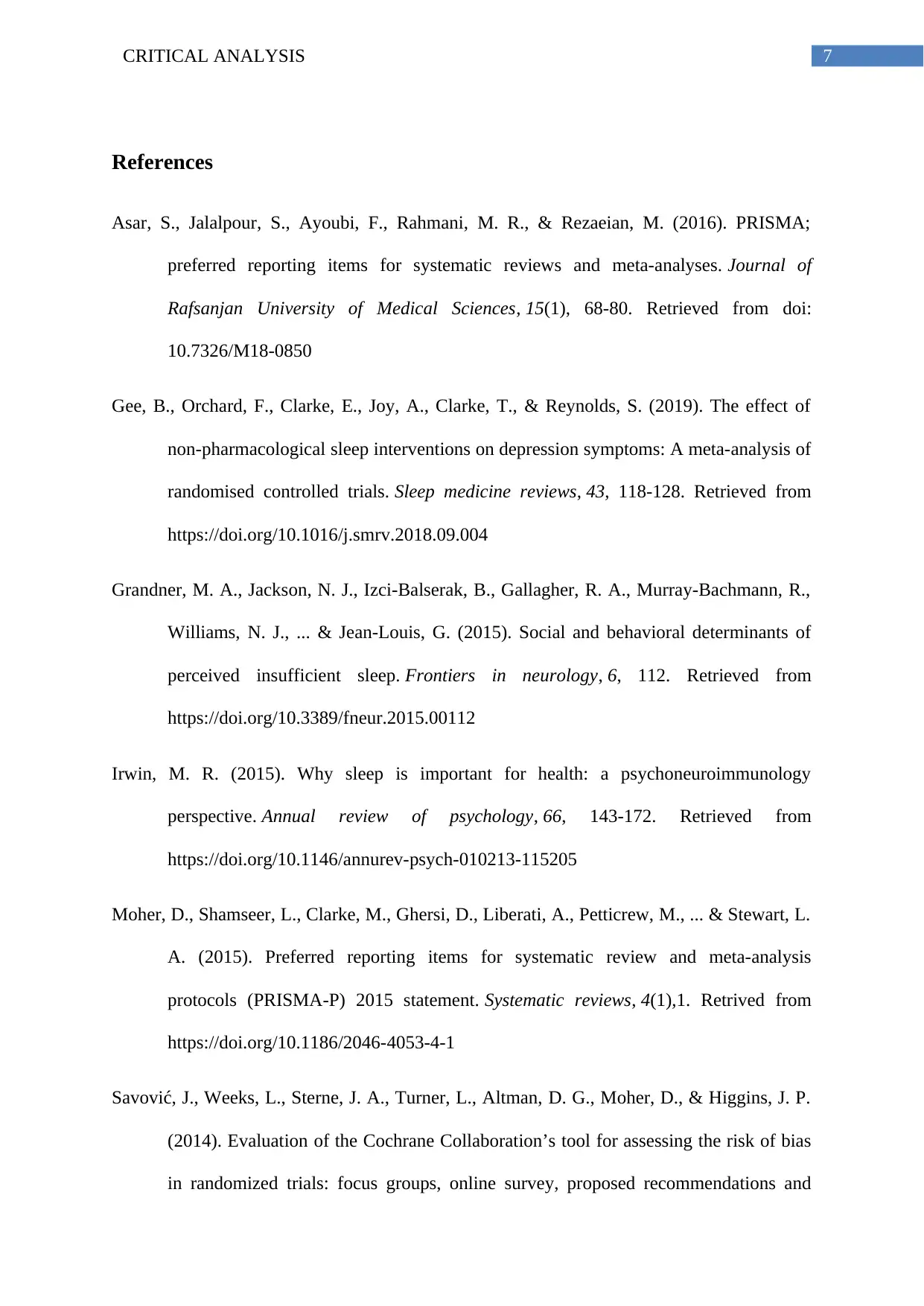
7CRITICAL ANALYSIS
References
Asar, S., Jalalpour, S., Ayoubi, F., Rahmani, M. R., & Rezaeian, M. (2016). PRISMA;
preferred reporting items for systematic reviews and meta-analyses. Journal of
Rafsanjan University of Medical Sciences, 15(1), 68-80. Retrieved from doi:
10.7326/M18-0850
Gee, B., Orchard, F., Clarke, E., Joy, A., Clarke, T., & Reynolds, S. (2019). The effect of
non-pharmacological sleep interventions on depression symptoms: A meta-analysis of
randomised controlled trials. Sleep medicine reviews, 43, 118-128. Retrieved from
https://doi.org/10.1016/j.smrv.2018.09.004
Grandner, M. A., Jackson, N. J., Izci-Balserak, B., Gallagher, R. A., Murray-Bachmann, R.,
Williams, N. J., ... & Jean-Louis, G. (2015). Social and behavioral determinants of
perceived insufficient sleep. Frontiers in neurology, 6, 112. Retrieved from
https://doi.org/10.3389/fneur.2015.00112
Irwin, M. R. (2015). Why sleep is important for health: a psychoneuroimmunology
perspective. Annual review of psychology, 66, 143-172. Retrieved from
https://doi.org/10.1146/annurev-psych-010213-115205
Moher, D., Shamseer, L., Clarke, M., Ghersi, D., Liberati, A., Petticrew, M., ... & Stewart, L.
A. (2015). Preferred reporting items for systematic review and meta-analysis
protocols (PRISMA-P) 2015 statement. Systematic reviews, 4(1),1. Retrived from
https://doi.org/10.1186/2046-4053-4-1
Savović, J., Weeks, L., Sterne, J. A., Turner, L., Altman, D. G., Moher, D., & Higgins, J. P.
(2014). Evaluation of the Cochrane Collaboration’s tool for assessing the risk of bias
in randomized trials: focus groups, online survey, proposed recommendations and
References
Asar, S., Jalalpour, S., Ayoubi, F., Rahmani, M. R., & Rezaeian, M. (2016). PRISMA;
preferred reporting items for systematic reviews and meta-analyses. Journal of
Rafsanjan University of Medical Sciences, 15(1), 68-80. Retrieved from doi:
10.7326/M18-0850
Gee, B., Orchard, F., Clarke, E., Joy, A., Clarke, T., & Reynolds, S. (2019). The effect of
non-pharmacological sleep interventions on depression symptoms: A meta-analysis of
randomised controlled trials. Sleep medicine reviews, 43, 118-128. Retrieved from
https://doi.org/10.1016/j.smrv.2018.09.004
Grandner, M. A., Jackson, N. J., Izci-Balserak, B., Gallagher, R. A., Murray-Bachmann, R.,
Williams, N. J., ... & Jean-Louis, G. (2015). Social and behavioral determinants of
perceived insufficient sleep. Frontiers in neurology, 6, 112. Retrieved from
https://doi.org/10.3389/fneur.2015.00112
Irwin, M. R. (2015). Why sleep is important for health: a psychoneuroimmunology
perspective. Annual review of psychology, 66, 143-172. Retrieved from
https://doi.org/10.1146/annurev-psych-010213-115205
Moher, D., Shamseer, L., Clarke, M., Ghersi, D., Liberati, A., Petticrew, M., ... & Stewart, L.
A. (2015). Preferred reporting items for systematic review and meta-analysis
protocols (PRISMA-P) 2015 statement. Systematic reviews, 4(1),1. Retrived from
https://doi.org/10.1186/2046-4053-4-1
Savović, J., Weeks, L., Sterne, J. A., Turner, L., Altman, D. G., Moher, D., & Higgins, J. P.
(2014). Evaluation of the Cochrane Collaboration’s tool for assessing the risk of bias
in randomized trials: focus groups, online survey, proposed recommendations and
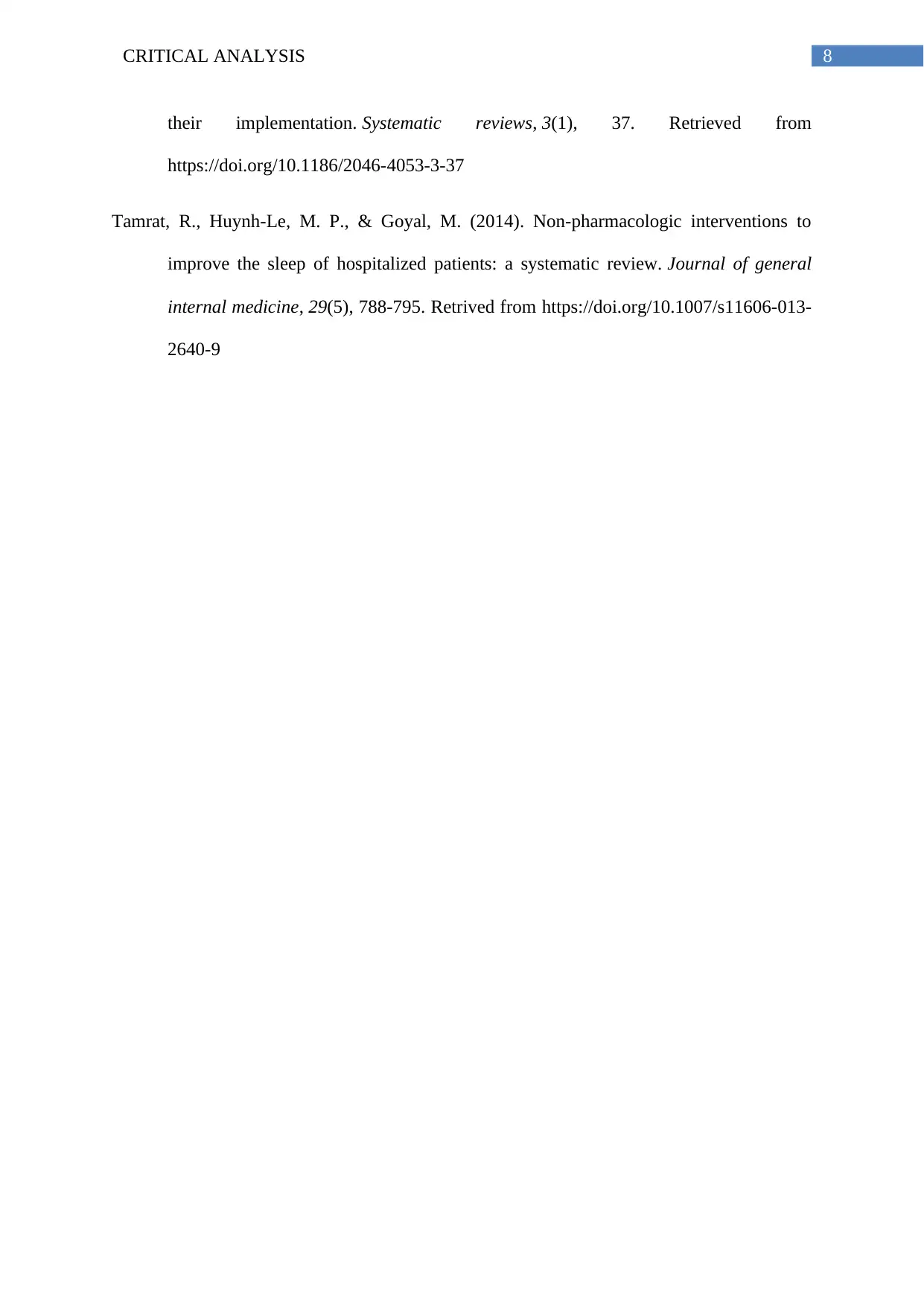
8CRITICAL ANALYSIS
their implementation. Systematic reviews, 3(1), 37. Retrieved from
https://doi.org/10.1186/2046-4053-3-37
Tamrat, R., Huynh-Le, M. P., & Goyal, M. (2014). Non-pharmacologic interventions to
improve the sleep of hospitalized patients: a systematic review. Journal of general
internal medicine, 29(5), 788-795. Retrived from https://doi.org/10.1007/s11606-013-
2640-9
their implementation. Systematic reviews, 3(1), 37. Retrieved from
https://doi.org/10.1186/2046-4053-3-37
Tamrat, R., Huynh-Le, M. P., & Goyal, M. (2014). Non-pharmacologic interventions to
improve the sleep of hospitalized patients: a systematic review. Journal of general
internal medicine, 29(5), 788-795. Retrived from https://doi.org/10.1007/s11606-013-
2640-9
⊘ This is a preview!⊘
Do you want full access?
Subscribe today to unlock all pages.

Trusted by 1+ million students worldwide
1 out of 9
Related Documents
Your All-in-One AI-Powered Toolkit for Academic Success.
+13062052269
info@desklib.com
Available 24*7 on WhatsApp / Email
![[object Object]](/_next/static/media/star-bottom.7253800d.svg)
Unlock your academic potential
Copyright © 2020–2025 A2Z Services. All Rights Reserved. Developed and managed by ZUCOL.





